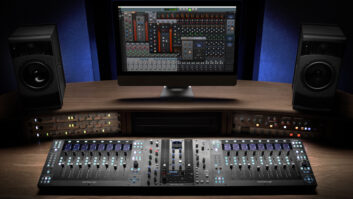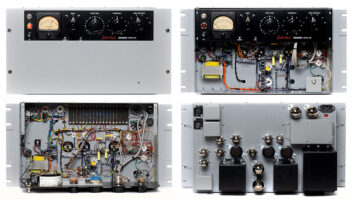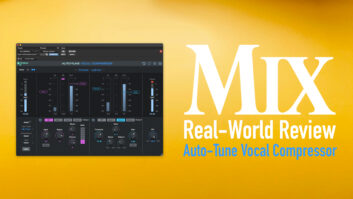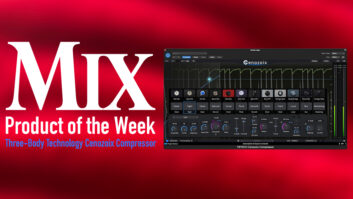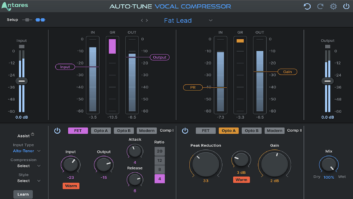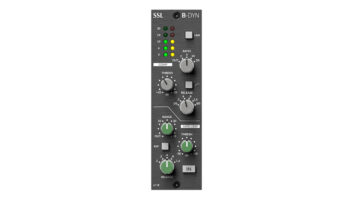
The TDM-only CL1 B emulates the hardware version with its Fixed, Manual and Fix/Man modes.
Introduced in the mid-’80s, the three-rackspace, single-channel Tube-Tech CL1 B compressor/limiter became a coveted and trusted dynamics processor noted for its great sound in a wide range of applications. The CL1 B has its optical gain-changing element (LED- and light-dependent resistor) placed directly after the input transformer, so there’s no added coloration or distortion from an audio input amplifier. Two solid-state, time-constant circuits (one fixed, the other for variable or manual) control the opto element’s attack and release characteristics, followed by an all-tube signal path with up to 30 dBU of makeup gain. For external sidechain interconnection, the CL1 B uses two buses. Up to 10 units can be slaved for processing multitrack stems or surround material.
ENTER THE VIRTUAL CL1 B
Previously offered only for TC Electronic PowerCore users, the Tube-Tech CL1 B virtual compressor/limiter plug-in is now available for Digidesign Pro Tools HD, HD Accel and VENUE systems. It’s for TDM systems only (Mac or PC) and works at sample rates up to 96 kHz, precisely emulating the hardware unit in all ways — including its Fixed, Manual and Fix/Man modes.
Fixed mode has 1ms attack and 50ms release times. Manual mode has controls for continuously varying attack from 0.5 to 300 ms and release times from 50 ms to 10 seconds. The plug-in retains the hardware CL1 B’s unique Fix/Man mode, which combines the attack/release times of Fixed and Manual modes. Designed for program compression, Fix/Man’s attack time is the same as Fixed as long as program peaks are longer than or equal to the attack time setting. For program peaks that are shorter than the attack time setting, the attack time can control or delay the onset of the release timing.
The Fix/Man mode results in a variable release with a constant fast attack (when fully counterclockwise). You’ll have faster release times for short-duration peaks and longer release times for program peaks with longer expires.
You can vary the compression ratio from 1:1 to 10:1, and a large VU displays input, output and gain-reduction levels. The stereo plug-in version allows you to select the channel — left, right or a combination — that drives gain reduction.
TAKING IT FOR A DRIVE
After installing CL1 B into my Pro Tools HD3 Accel rig and authorizing via iLok, I replaced my usual compressor choices for vocals, bass, drums and backing vocal stems. At 48kHz sample rates, one mono or stereo instance uses 50 percent of a chip while 96kHz sessions use an entire chip per instance. Its 28 presets offer many good starting points. You can toggle between A/B compressor settings. “A” lights up as soon as you tweak any preset. Click “B” to create another setting, and clicking on “A” returns to the first setup.
My first session had a difficult male vocal track that eluded previous processing, with no middle ground between oversquashed and loose control. The CL1 B’s Male Vocal preset came ready to work with fixed attack and release times (those knobs were grayed out), so I changed to Manual mode and lengthened the attack time to regain some lost brilliance and experiment with different ratio settings. In Manual, I had to reset the threshold, which was too bad because I liked the preset value. I wish that the current values of attack, release, threshold, ratio and makeup gain were indicated in boxes in which you could type values.
As with the hardware unit, the singer sounded full and had a very high fidelity — when peaks resulted in 10 dB or more of gain reduction, the vocal didn’t sound distorted or extremely dulled out.
The next track was a Fender bass. Like its hardware cousin, the CL1 B plug-in may be the best compressor for bass guitar because it’s clean, yet offers a tube warmth that imparts harmonic richness. I used Fix/Man mode so that the attack time turned into a kind of hold function. This gave me the best of both worlds: a long release time for the legato bits — whole notes in the verses — and then faster release times for the straight eighth notes in the choruses. I set the attack control to the full-clockwise position and release to about 2 o’clock. The verse “footballs” were held to a constant level while the eighth notes in the chorus chugged along evenly.
On kick drums, the CL1 B tightened the low frequencies considerably. I started with the Kick Drum preset and got more punch and aggressive attack with little sacrifice of the drum’s acoustical size. The CL1 B will do its own unique version of “crazy drum limiter” that’s cleaner (with fewer distortion artifacts) than other plugs. Set the ratio to 10:1, turn the threshold down to about -40 dB and set a fast attack time, but play around with the attack time and the release time depending on a song’s tempo and the drummer’s style.
I used my ears more than the CL1 B’s metering — what looks like a lot of gain reduction on the meter doesn’t necessarily sound like it. It’s easy to overload the plug-in, with red LEDs lighting up long before the GUI’s output meter reaches mid-scale.
But my ears kept confirming that the CL1 B sounds great — it was excellent on every source I tried. And like the hardware unit, its smooth operation and fat sound never disappoint. The CL1 B is first-call and first-class for vocals, bass and guitars — but use it on any source. At $995, it’s a winner.
Tube-Tech, dist. by TC Electronic, 818/665-4900, www.tcelectronic.com, www.tube-tech.com.
